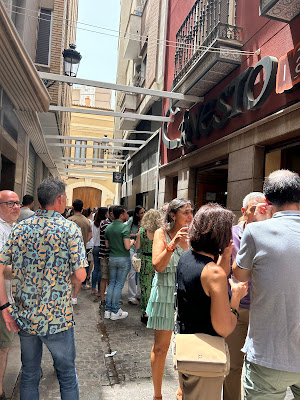We like to think of ourselves as good immigrants, Danielle and I. That makes us want to get familiar with our new host country and, specifically, with the region where we live. That’s the Autonomous Community of Valencia, as it’s grandly called, with its three provinces: Valencia itself (the one we live in) with Alicante to the south and Castellón to the north.
Now we’ve been to Castellón province several times and discovered that it has many glorious towns and much wonderful countryside, with hills and woods running from the border with Aragon to the west, down to a coastal plain with its sun-drenched Mediterranean beaches. But, somehow, until a few weeks ago, we’d never been to Castellón city itself, the place that gave the province its name. So when Danielle saw that the council was organising a guided tour of the ceramics of the city, we signed up for it.
We met the group on the edge of a fine park in the centre of town, the Ribalta Park, named for a painter, Francisco Ribalta. A fine introduction to the fine fakery we were to encounter on our tour.
 |
| Rather a fine park |
 |
| Castellón's House of the Storks. Which isn’t |
We also visited a lovely house on the square outside the park, known as the ‘House of the Storks’. At first glance, you can see that the house owes its name to the wonderful climbing series of ceramic tiles on the front of the building, each set of which apparently rests on a bottom tile with a picture of a bird. The stork that gave its name to the building. Except that when you look closely at it, you discover that it isn’t a stork at all.
 |
| Call that a stork? |
It’s a heron. Heron House? La casa de las garzas? Did someone decide that casa de las cigüeñas sounded better? Or did an early error consecrated by simple habit establish the name in the mind of the population?
The city also has a cathedral. Except that it isn’t a cathedral. There’s a local bishop but his seat isn’t in Castellón city itself but in Segorbe, a glorious city further up the long valley that runs westwards through the province to Aragon. I’ve been told that Segorbe had hoped it would be the capital of the province and give it its name, but Castellón beat it to that honour. The bishop, though, stayed in Segorbe, so the large church in the middle of the provincial capital isn’t really a cathedral – a bishop’s main church – but a co-cathedral, a sort of associate cathedral, a tad second best.
It was funny to come across all these things that weren’t what they seemed. A native son who wasn’t. Herons claimed as storks. A church the size of a cathedral which wasn’t one. Funny and fun. But I don’t want to give the impression that everything in Castellón was just fakery. There was much that was authentic and beautiful.
There were some fine buildings.
And there were loads of ceramics.
On park benches:
On drinking fountains:
Even on modern buildings:
That underlined the fact that this isn’t an art for a museum, but something living and flourishing to this day.We particularly liked the ceramic advert outside what was once a dairy. It proudly claimed that the milking was done in the presence of the public. Our guide told us that you could choose which cow you wanted your milk from.
And it wasn’t just ceramics. Just as authentic was the way the people of Castellón enjoyed themselves. We stopped for a simple but excellent lunch in a side street, rowdy and cheerful with a loud crowd, which became deafening when a hen party showed up. Group after group standing or sitting outside the cafés and restaurants of the street cheered the hen party and shouted congratulations to the bride as they danced by.
 |
| A cheerful atmosphere for lunch |
 |
| Further enlivened by a joyful bride |





No comments:
Post a Comment